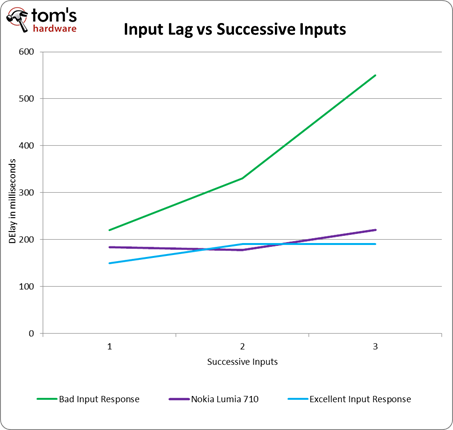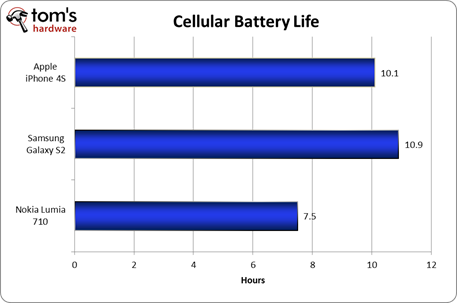Nokia Lumia 710 Review: Windows Phone 7 On A Budget
Nokia's Lumia 710 is designed to make Windows Phone 7 accessible to the masses. How does it fare under our test suite? You might be surprised. We're starting down the path of smartphone testing with a different take and a few exclusive benchmarks as well.
Input Lag And Battery Life
Input Lag
Any time you use a device with a touchscreen, input lag becomes a measurement to which you want to pay attention.
It's difficult to quantify input lag, though. In our tablet reviews, we use a 1000 FPS high-speed camera to measure the time it takes between touching the screen and it reflecting the action. But that only captures the delay of one tap. In the real world, though, second and third inputs often take longer to register.
So, now, we're measuring input lag over successive taps. Frankly, this is probably most pertinent to typing on a tablet's on-screen keyboard. However, it's a good worst-case exercise here as well.
A "bad phone" would demonstrate higher input lag over successive taps. Clearly, that's not what we see here. Despite the fact that Nokia positions the Lumia 710 as a budget-oriented smartphone, we're impressed with its responsiveness.
The only caveat is that lag does increase when CPU utilization is already high. For example, it exceeds 300 ms if you try to scroll when the ESPN app first starts up. We're curious to see if the Lumia 800 exhibits different behavior. Though its internals are very much similar, it's possible that the AMOLED screen could yield dissimilar results.
Battery Life
Get Tom's Hardware's best news and in-depth reviews, straight to your inbox.
Our cellular battery life test is pretty straightforward. We record two sides of an actual conversation, call a POTS line, and play each unique side back through the phones in 90 second intervals until the mobile device runs out of juice.
Although the Lumia 710 ranks behind the iPhone 4S and Galaxy S2, the result isn't bad for continuous talk time. Nokia's official specs put the phone's standby time at 400 hours.
We're still undecided as to how we want to measure battery life during Web browsing. Should our benchmark involve rendering a graphics-heavy website like cnn.com? What about something text-heavy, such as Wikipedia? Should we play MP3s in the background? Sound off in our comments section and let us know what you'd like to see.
Current page: Input Lag And Battery Life
Prev Page Video Samples: Great During The Day; Bad At Night Next Page Lumia 710: Nokia Is Back At It-
DjEaZy ... M$ owns skype and partially nokia... but there is no frontfacing camera to do videocalls?Reply -
joytech22 DjEaZy... M$ owns skype and partially nokia... but there is no frontfacing camera to do videocalls?Reply
Not quite sure how many people even use the feature.
Out of everybody you see when you go out, count the amount of people video calling compared to making a regular call. -
alikum DjEaZy... M$ owns skype and partially nokia... but there is no frontfacing camera to do videocalls?Not for the first Lumia line. They were on tight schedule. Other WP phones have it, check out HTC Titan and Radar.Reply -
zybch DjEaZy... M$ owns skype and partially nokia... but there is no frontfacing camera to do videocalls?MS hasn't had time to do much with skype yet, the sale hasn't been long approved despite being announced a long time ago).Reply
The mid-year WP7 update, Tango, will reportedly add skype functionality.
As for actually using skype, I have had android phones and tablets with it but I have never bothered to use it. My HTC Titan has a nice front facing camera, but I'd have rather they took it out and cut the cost by $20 for all the use its going to get. -
ksampanna "We asked the Tom's Hardware audience for some of their favorites on Facebook and received a pretty tepid response"Reply
that was the problem ... -
feeddagoat I was very impressed with the Lumia 800. Nice screeen, different from everythign else (Yes same as N9 but it was very nicely made and a phone you could get in cyan without looking like a complete tool) Only thing put me off it was lack of HDMI out, frontfacing camera and better apps selection on android. My last phone was a blackberry and it had 2 key things android doesn'tReply
1. Universal mail box
2. Browser doesn't close if I switch apps
My question is simple, how well does the Lumia 710 handle switching between tasks? Does it manage it as well as blackberry and is the mail box universal?
Personally frontfacing cam, and HDMI out and that phones a winner for me. Add a keyboard and I'll worship it lol. -
theuniquegamer I have been using it for last 2 months and i am satisfied with the performance. This is the best wp7 (mango) bang for buck.Reply -
southernshark joytech22Not quite sure how many people even use the feature.Out of everybody you see when you go out, count the amount of people video calling compared to making a regular call.Reply
Depends on where you are at buddy boy. If you live in the USA, then you are probably right (although I have skyped to an Ipod in the US). But move yourself outside of the country, where 95 percent of the worlds population lives. Now you want to call someone from country to country... on a cell phone... its expensive. Or I can go to a free Wifi spot and use Skype absolutely free.
I know its cool to think that every product on earth will only be used in middle class America, but that may not be such a great view point if you are actually in business (even though it is the same viewpoint that caused the USA to fail). -
grillz9909 ReplyWP7-based phones have three non-touchscreen keys: Back, Home, and Search.
Just nit-picking here, but the samsung focus has touchscreen keys for the back, home, and search. Just saying.


